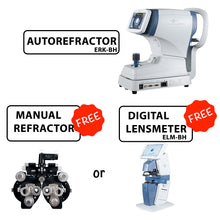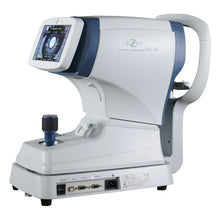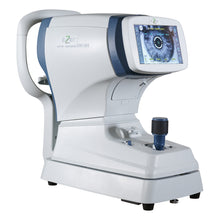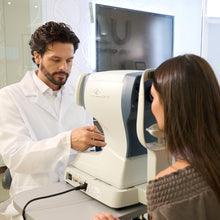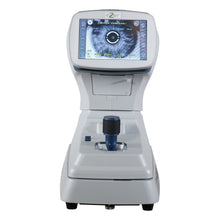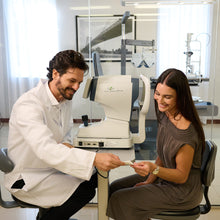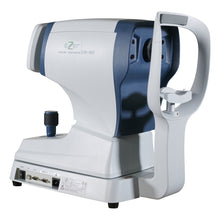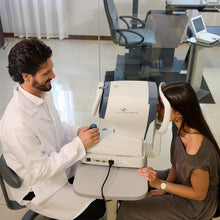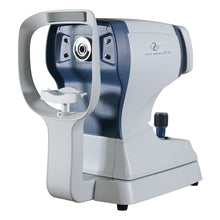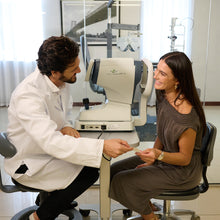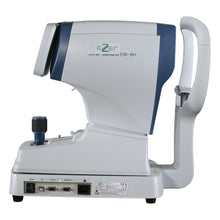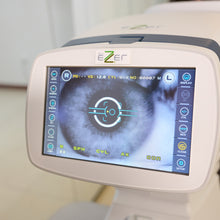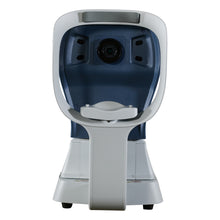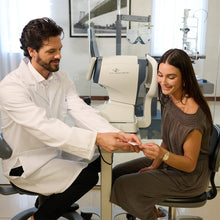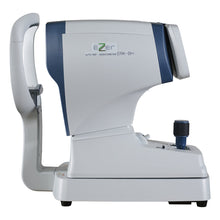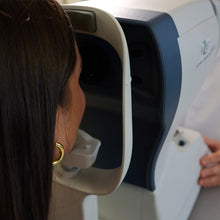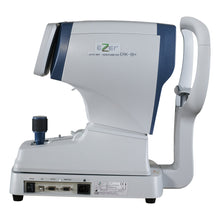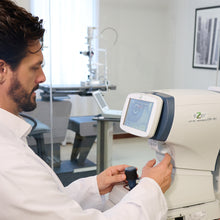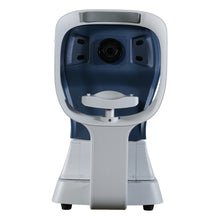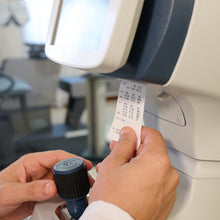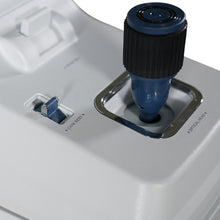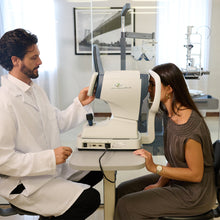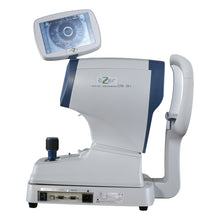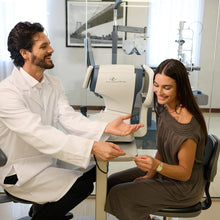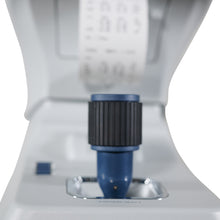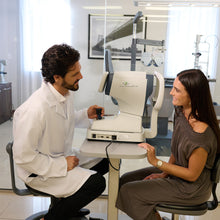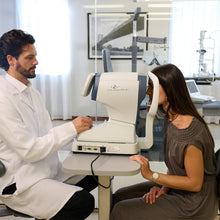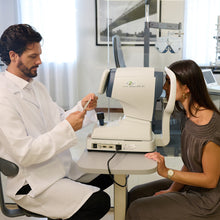Ezer Autorefractor Keratometer ERK-BH
The Autorefractor Keratometer ERK-BH is a cutting-edge device designed for precise and efficient measurement of refractive errors and corneal curvature. With advanced technology and intuitive operation, it provides accurate readings to aid in the diagnosis and treatment of vision-related conditions. The ERK-BH offers a comprehensive analysis of the eye, including autorefraction and keratometry, allowing eye care professionals to obtain essential information for contact lens fitting, refractive surgery planning, and general eye health assessment. Its user-friendly interface and quick measurement capabilities make it an ideal tool for enhancing patient care and optimizing clinical workflow. The Autorefractor Keratometer ERK-BH is a reliable and valuable instrument that contributes to precise vision correction and comprehensive eye care.

After a patient is adjusted comfortably using the motorized chinrest, clinicians can take advantage of an enhanced no-load joystick for alignment of the eye. Once aligned, the ERK-BH performs auto-refraction and keratometry with just one press of the joystick button. The ERK-BH can get precise measurements on even the most myopic or hyperopic of patients, with its expansive dioptric measurement range (-30.00 D to +25.00 D). By directing the patient’s gaze to the peripheral fixation lamps, peripheral corneal curvature measurements can be obtained with the tap of a button. The ERK-BH has an equally exceptional range for corneal radius of curvature measurements (5.0 mm to 13.0 mm).

Peripheral corneal curvatures can be measured by having the patient look at the peripheral fixation lamps. Measuring the corneal periphery helps with the evaluation of irregular astigmatism, and aids in contact lens fitting. There are two lighting modes for the peripheral fixation lamps: AUTO / MANU.

The CF(Comparison of vision function) mode allows the examiness to experience the corrected vision by applying additional degrees. If the examinee is not presbyopia or primitive, it may be difficult to feel the effect.
Not only can the practitioner obtain measurements for the usual refractometry and keratometry, but they can also measure corneal diameter and base curve for contact lens fitting. Thus, measurements of the eye and measurements for prescriptions glasses and contact lenses can be obtained more efficiently.

The diameter of cornea can be measured in SIZE Mode for prescribing contact lens. The size of pupil can also measured to see how much it is dilated, and the size of contact lens can be measured without having the examinee remove it.

By directing light into the pupil using ILLUM mode, cataracts can be evaluated, as can the surface of contact lenses.

IOL Mode

K/R Mode

KER Mode

REF Mode

The built-in software of the ERK-BH enables easy diameter measurements using the freeze mode, where measurements of the diameter of the cornea, pupil or hard contact lenses worn by the patient can be taken. By simply touching and dragging the screen with your finger, these measurements are calculated exactly.

The device’s improved retroillumination mode helps to expose damage to hard contact lenses. In addition, this device has built-in calculations for patients with intraocular lenses or cataracts.

Ten images and results can be checked simultaneously through an enhanced display control system.
Black/White User Interface Option
The user can select a Black or White user interface according to their preference.

To make measurements of a cataract patient easier, simply turn on the "IOL" function.
The equipment can perform automatic height adjustments based on pupil position, reducing exam time. With the click of a button, the user can switch from Auto to Manual tracking mode. Measurement convenience and accuracy are increased through the addition of position guidance, designed to easily track the eye.

The user can easily determine if a patient requires an add through a vision simulation. The patient can compare the effects before and after the correction through a near vision simulation.

Operation and setup are a breeze with the ERK-BH’s expanded 7-inch (800x480) LCD touchscreen monitor. Users can avoid neck and back strain with the adjustable touchscreen. It swivels up and down by 180° and left and right from 135-145°. By tapping the appropriate icon, the user can change various settings quickly and easily.

The screen can be shared from all directions, regardless of the positioning of the patient or the examiner.

The data from the ten most recent exams can be uploaded with the touch of a button, and a builtin printer allows users make print records during the examination. Data can then easily be transferred to other devices using a USB or RS-232 cable.
Simply touch the icon on the screen to see any changed settings. The touchscreen supports interactive setting changes quickly and conveniently to save the user precious time.

The chinrest is motorized and can be adjusted by the operator using a conveniently positioned switch. This design makes for simple adjustment of the chinrest when switching from patient to patient. The motor is controlled easily by pressing the switch up or down.

The no-load joystick ensures a softer eye examination, as the user can take obtain measurements without vibrational interference. This system allows for a more accurate measurement as compared to the previous generation belt-type joystick.
Stage-Lock
The main body of the machine can easily be fixed to the base with the convenient one-touch lock.

The ERK-BH provides an immediate and complete printout of measurement results. The auto printer cutter is included for this added convenience. The economy printer mode can be used to save paper by displaying results in a more compact manner by minimizing print size.

The ERK-BH can connect to several other digital ophthalmic instruments by Ezer to serve as the hub of the digitally-enabled exam room. Data can be entered manually or transferred directly from compatible devices, and the control box can operate many of the different functions on each device.

What is an EMR?
Electronic Medical Records, commonly abbreviated as “EMR”, are a technological tool used widely in modern medical practices. EMR systems were designed to replace outdated paper charting methods and streamline the collection and tracking of patient data over time. EMR platforms integrate the various components of a doctor’s office visit, including intake demographics and medical history, prescription information, laboratory data, practice management software, exam notes, and more.
Overall, EMR systems are used to promote economic efficiency and improved patient care through a seamless coordination of data collection and storage. EMR platforms also increase patient transparency through use of portals where patients can view important results and communicate with Doctor’s in a secure manner.

In the Ophthalmic industry, EMR are becoming more important and popular than ever. The ability to save critical lab data relating to prescriptions and diagnoses while maintaining quick access to that information is key in decreasing chair time and improving patient outcomes and satisfaction.
With the Ezer Digital Practice, information sharing is easier than ever! The ELM-BH Lensometer, ERK-H/BH Autorefractor, EDR-H Phoropter, and EDC-BH Visual Acuity Chart all interact via Wifi to streamline communication between your pretest and exam rooms.
We know it can be scary to introduce a new technology to your practice, but with the Ezer Digital Practice equipment and US Ophthalmic’s superior tech support, your practice will save time and money with a seamless EMR integration.
| Our EMR Partners |

|

|

Click here to see the brochure

Click here to see the manual
| Measurement Modes | |
| K/R Mode | Continuous Keratometry and Refractometry |
| REF Mode | Refractometry |
| KER Mode | Keratometry |
| CLBC Mode | Contact Lens Base Curve Measurement |
| K(P) Mode | Peripheral Keratometry |
| Refractometry | |
| Vertex Distance(VD) | 0.0/12.0/13.5/15.0 |
| Sphere(SPH) | -30.00 ~ +25.00D (when VD=0.5in/12mm, Increments : 0.12 and 0.25D) |
| Cylinder(CYL) | 0.00 ~ ±10.00D (Increments : 0.12 and 0.25D) |
| Axis(AX) | 1 ~ 180° (Increments : 1°) |
| Cylinder Form | -,+,MIX |
| Pupil Distance(PD) | 0.4 ~ 3.5in (10 ~ 88mm) |
| Minimum Pupil Diameter | Ø0.08in (Ø2.0mm) |
| Keratometry | |
| Radius of Curvature | 0.2 ~ 0.5in (Increments : 0.0004in) (5.0 ~ 13.0mm (Increments : 0.01mm)) |
| Corneal Power | 25.96 ~ 67.50D (when cornea equivalent refractive index is 1.3375) (Increments : 0.05/0.12/0.25D) |
| Corneal Astigmatism | 0.00 ~ -15.00D (Increments : 0.05/0.12/0.25D) |
| Axis | 1 ~ 180° (Increments : 1°) |
| Environment Requirements | |
| Operation |
Temperature:+10 to +40℃ Humidity:30 to 85% RH Atmospheric pressure:70 to 106kPa |
| Storage & Transportation |
Temperature:-10 to +55℃ Humidity:10 to 95% RH Atmospheric pressure:50 to 106kPa |
| Others | |
| Corneal Diameter | 0.08 ~ 0.55in (Increments : 0.004in) (2.0 ~ 14.0mm (Increments : 0.1mm)) |
| Memory of Data | 10 measured value for each eye |
| Internal Printer | Thermal line printer with Auto - Cutter function |
| Monitor | 7in (1778 mm) TFT-LCD (800 × 480 pixels tilting/swivel, Touch-Screen function) |
| Power Supply | AC100-240V, 50/60Hz |
| Dimensions | AApproximately 11(W) × 20(D) × 18(H)in (260(W) × 500(D) × 450(H)mm) |
| Weight | Approximately 44lb (20kg) |
| Measurement Modes | |
| K/R Mode | Continuous Keratometry and Refractometry |
| REF Mode | Refractometry |
| KER Mode | Keratometry |
| CLBC Mode | Contact Lens Base Curve Measurement |
| K(P) Mode | Peripheral Keratometry |
| Refractometry | |
| Vertex Distance(VD) | 0.0/12.0/13.5/15.0 |
| Sphere(SPH) | -30.00 ~ +25.00D (when VD=0.5in/12mm, Increments : 0.12 and 0.25D) |
| Cylinder(CYL) | 0.00 ~ ±10.00D (Increments : 0.12 and 0.25D) |
| Axis(AX) | 1 ~ 180° (Increments : 1°) |
| Cylinder Form | -,+,MIX |
| Pupil Distance(PD) | 0.4 ~ 3.5in (10 ~ 88mm) |
| Minimum Pupil Diameter | Ø0.08in (Ø2.0mm) |
| Keratometry | |
| Radius of Curvature | 0.2 ~ 0.5in (Increments : 0.0004in) (5.0 ~ 13.0mm (Increments : 0.01mm)) |
| Corneal Power | 25.96 ~ 67.50D (when cornea equivalent refractive index is 1.3375) (Increments : 0.05/0.12/0.25D) |
| Corneal Astigmatism | 0.00 ~ -15.00D (Increments : 0.05/0.12/0.25D) |
| Axis | 1 ~ 180° (Increments : 1°) |
| Environment Requirements | |
| Operation |
Temperature:+10 to +40℃ Humidity:30 to 85% RH Atmospheric pressure:70 to 106kPa |
| Storage & Transportation |
Temperature:-10 to +55℃ Humidity:10 to 95% RH Atmospheric pressure:50 to 106kPa |
| Others | |
| Corneal Diameter | 0.08 ~ 0.55in (Increments : 0.004in) (2.0 ~ 14.0mm (Increments : 0.1mm)) |
| Memory of Data | 10 measured value for each eye |
| Internal Printer | Thermal line printer with Auto - Cutter function |
| Monitor | 7in (1778 mm) TFT-LCD (800 × 480 pixels tilting/swivel, Touch-Screen function) |
| Power Supply | AC100-240V, 50/60Hz |
| Dimensions | AApproximately 11(W) × 20(D) × 18(H)in (260(W) × 500(D) × 450(H)mm) |
| Weight | Approximately 44lb (20kg) |
































